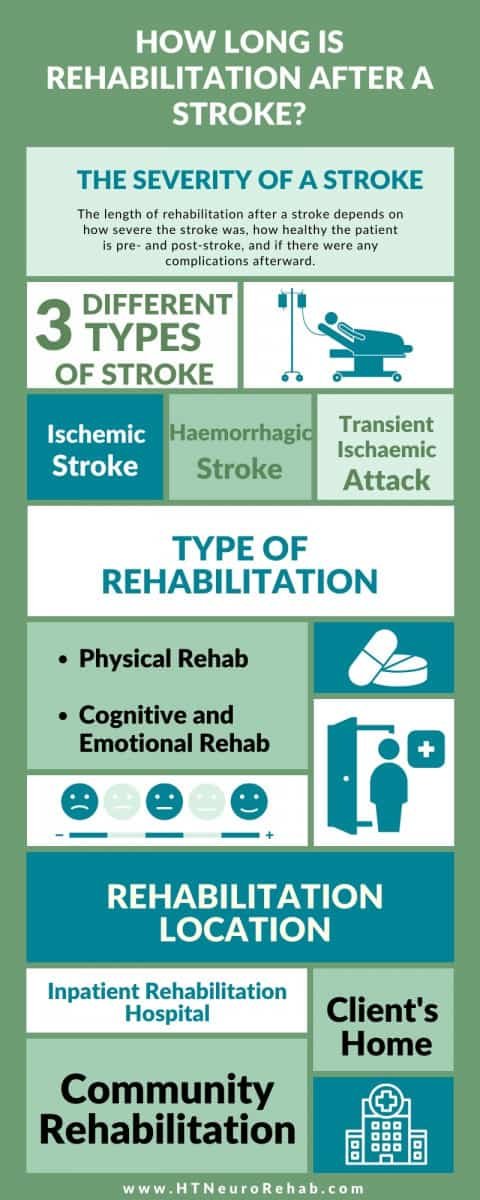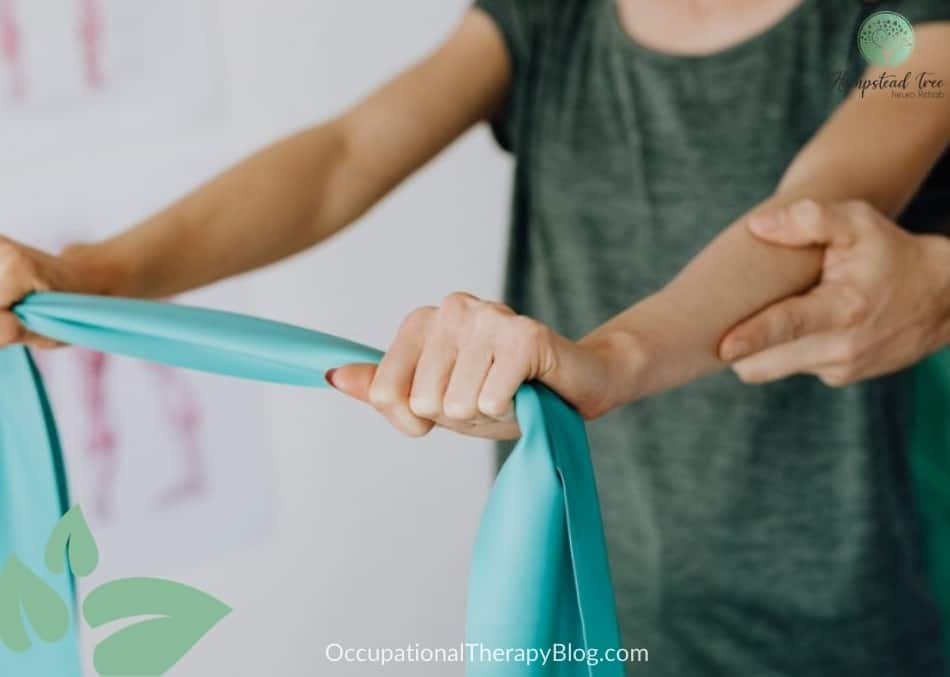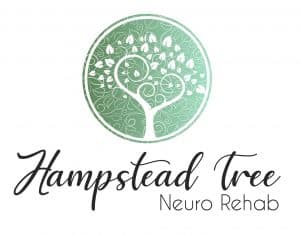
A stroke is one of the scariest health problems that a person can go through; having one can lead to a lifetime of complications from motor skills to brain function. Although coming back from a stroke can be difficult, fortunately, there are plenty of different rehabilitation techniques to regain what you might have lost. But how long does this process take?
The length of rehabilitation after a stroke depends on how severe the stroke was, how healthy the patient is pre- and post-stroke, and if there were any complications afterward. For some, it can be a month or two; for more severe cases, it can take years.
As you would expect, rehabilitation for a stroke does not follow the same pattern from person to person; each rehabilitation plan is tailored to each patient to best get their life back on track. Therefore, how long it takes for complete rehabilitation will depend on your specific circumstances—we’ll review what those factors are below.
The Severity of the Stroke
In short, a stroke occurs when the blood’s flow to the brain is either completely or partially blocked. As a result, brain tissues cannot obtain the necessary oxygen and nutrients, and cells begin to die within minutes.
The severity of your stroke will be the first factor that determines how long your rehabilitation will take. Naturally, with minor strokes, your rehabilitation time will be much shorter than those who have severe strokes and need more time for their brain cells to repair themselves.
There are three different kinds of strokes:
- Ischaemic Stroke – This is the most common stroke. It occurs as a result of the brain lacking blood flow.
- Haemorrhagic Stroke – This stroke occurs when there is bleeding in and/or around the brain.
- Transient Ischaemic Attack (TIA) – This is commonly known as a “mini-stroke.” The symptoms are all the same as a regular stroke, but they only last for a short time; this is because the blockage that leads to the reduced blood flow becomes unblocked.
Although a stroke can already cause health complications with the type of brain damage that occurs, there can be more damage done because of the brain cells dying—especially the more severe the stroke is:
- Brain Oedema: Swelling of the brain
- Seizure: Abnormal electrical activity in the brain
Depending on where in the brain the blockage happened and which brain cells died, the following can also occur:
- Speech impediment
- Memory loss
- Loss of motor functions
Along with cognitive effects, other physical health complications can occur post-stroke:
- Shoulder Pain: Results from the lack of support of an arm due to weakness or paralysis
- Deep Venous Thrombosis (DVT): Blood clots that can form in the legs because of reduced mobility or lack of circulation
- Muscle Contraction: Shortened muscles in an arm or leg from reduced mobility or lack of exercise or mobility (AHNI)
Rehabilitation seeks to resolve each of the complications listed above. The type of rehabilitation plan your physician creates for you will allow enough time for you to overcome each of these health issues comfortably.

Type of Rehabilitation
Following a stroke, it’s important that you start the rehabilitation process as soon as possible. Before a doctor clears you, they usually will have to stabilize your condition and limit any more stroke-related complications.
However, once a doctor releases you, you should begin rehabilitation within 24-48 hours. It is usually recommended that patients start with 45 minutes of stroke rehabilitation therapy, five days per week.
The quicker you begin rehabilitating, the better chance you will regain full mobility and brain function—sometimes at a faster pace than if you were to delay treatment. You can even reduce the likelihood of other stroke complications from happening in the future.
The type of rehabilitation you pursue after a stroke will also affect how long it takes for you to recover completely. You will likely have to participate in two rehabilitation categories, each with various forms of rehab:
- Physical Rehab: This is usually the first part of stroke rehabilitation. The goal is to help the patient regain their physical ability has either been reduced or lost due to the stroke.
- Motor-Skill Rehab: This is all about regaining any lost motor skills and strengthening muscles. Along with that, there is special rehabilitation to aid with swallowing.
- Mobility Training: This involves teaching patients how to live with and use mobility aids such as canes, walkers, wheelchairs, or ankle braces.
- Constraint-Induced Therapy: Strokes usually affect just one side of the body, so this type of rehab constrains the body’s unaffected side to help strengthen the affected muscles and limbs.
- Range-of-Motion Therapy: This therapy helps ease any muscle constraints and give back range of motion to a stroke victim.
- Cognitive and Emotional Rehab: Along with the physical side of rehabilitation, there is a lot of mental and emotional rehabilitation for a stroke victim.
- Cognitive-Loss Therapy: This is designed to help a person regain cognitive abilities like memory, social skills, problem-solving, judgment, and safety awareness.
- Communication-Loss Therapy: This type of rehab is critical for stroke victims because of the potential to lose their speaking ability. This might involve two different forms of therapy: one if a victim has a droop or facial paralysis and the other if part of the patient’s brain associated with speech is affected.
- Psychological Assessment: Strokes can be a traumatic event, and having a support group or therapy to deal with their emotional impact is important.
As you can see, the only difference between these rehabilitation forms is the different parts of the body and brain they target to recover, and the time it takes to work on them will vary. For most patients, rehabilitation will happen multiple days a week. Each session lasts anywhere from 15 minutes to a couple of hours, depending on what the patient is working on that particular day.

Rehabilitation Location
Rehabilitation can take place in numerous locations:
- The most common is a rehabilitation clinic, where the doctors, physicians, nurses, and the rest of the staff specialize in getting stroke victims back on their feet and living their lives.
- Another option would be back in a hospital where some locations have specialized sections or wings to help.
- There are also in-home options where physicians are dispatched to the victim’s home.
Most experts agree that rehabilitation at a specified facility is the best route to get a full treatment in less time. For one, the facility already has all the equipment and staff on-hand required for the process. Along with this, the atmosphere at a rehabilitation facility is suited for those going through the process, with books and other resources available to help.
Doing at-home rehabilitation can also be effective, but perhaps on a lower level. The first disadvantage of at-home rehab is that the physician or occupational therapist will have to bring all the equipment necessary to conduct treatments or sessions. Along with that, there needs to be adequate space to do the movements required for physical rehab.
Overall, the preference of where to participate in rehabilitation is up to the patient and whether they have reliable transportation to-and-from the facility or feel more comfortable doing everything in their own residence.
In Summary
Strokes are some of the scariest and most complicated medical issues a person can have. Although these events can significantly impact a person’s physical and mental health, rehabilitation makes it possible for anyone to get their life back to the way it was. The actual time it takes for patients to completely recover after a stroke with rehabilitation will depend on their circumstances. For some patients, the entire rehabilitation process can take a few weeks, while it may take months or even years for others. It all depends on your stroke’s severity, what type of rehabilitation you pursue, and how you progress during.
Content Disclaimer
The information contained above is provided for information purposes only. The contents of this Blog article are not intended to amount to advice, and you should not rely on any of the contents of this Blog article. Professional advice should be obtained before taking or refraining from taking any action as a result of the contents of this Blog article. OccupationaltherapyBlog disclaims all liability and responsibility arising from any reliance placed on any of the contents of this Blog article.

